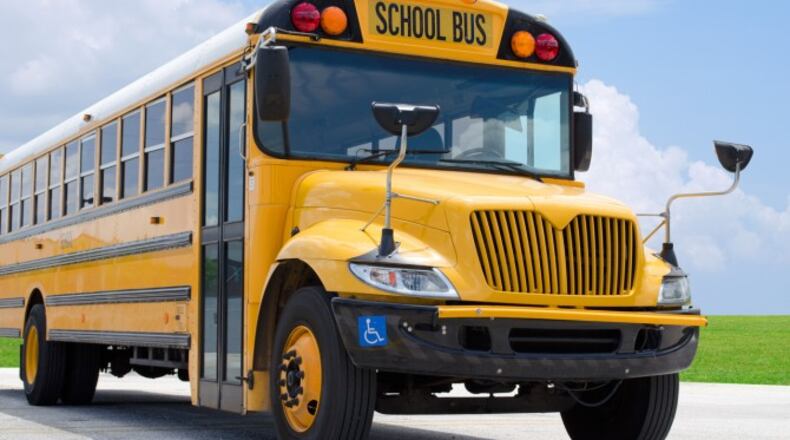The candidates debated Tuesday night at the downtown Dayton library. The event was hosted by The League of Women Voters, the Dayton Daily News, WHIO and UpDayton.
VOTERS GUIDE: Find out what's on your ballot this November
To see the candidates' detailed answers to 16 questions, see our voters guide here.
Here are their full answers to two recent Dayton Daily News questions.
Q: If you had to choose between the two, would you hire more teachers to lower class size, or hire more counselors/social workers/mental-health therapists to deal with non-academic issues?
Joe Lacey: I would choose to increase the number of teachers to lower class size. Our teachers deal with non-academic issues every day. Counselors/social workers/mental-health therapists are important to our district and I applaud their work but if I had to choose I would choose lower class sizes.
Gabriela Pickett: Ideally we do both, but if I had to choose, I would pick increasing the number of teachers, as classroom instruction quality and class size is one of the best ways to improve student outcomes. But our focus should not be on choosing between the two of these options. We should be finding ways to bring in more revenue to the school system so we can increase both teaching staff and support staff. These are two halves of the equation. Our counselors and mental health workers are absolutely vital for addressing the mental health crisis in our schools, and they can't be treated like an afterthought. Teachers and mental health professionals working together is the key.
RELATED: DPS, architect dispute renovation problems
RELATED: Plan to expand mental health services delayed
Dion Sampson: Increase the number of counselors/social workers/mental health therapist. We have to have people in place that can help our students deal with life and the many things that they are dealing with.
Will Smith: This is an interesting question. For me, the answer is making sure that we do what is necessary to better the learning environment in our schools. That means making sure that our teachers are given the necessary tools to perform at their highest level. In order to make that a reality, we need to work on both of these things. It isn't a "this or that" type of solution. Having counselors, social workers, and mental health therapists are a must in a district that faces the types of challenges we have in our community. Making sure they are readily available and working in tandem with the teachers can be a huge benefit. Class sizes are definitely a problem, but more teachers doesn't address the totality of the issue. We need more highly trained teachers as well as support staff to address other needs that many of our students face. As the parent of a special needs student, I have seen what having good wraparound support has done for my child.
Q: Should DPS use a neighborhood system, where the vast majority of students attend the school that’s closest to their home? Or a magnet system, with students traveling to schools designed around arts, or STEM or Montessori models?
Joe Lacey: Currently DPS is not a neighborhood system. At registration, families generally may choose any elementary school from a list of sixteen elementary schools. This hurts our community's sense of ownership of our schools and creates a nightmare for our school transportation system. The district should move to a neighborhood system for elementary schools with the exception of the Montessori school which is centrally located in the district. Families that live in the neighborhood or region around a school should be given priority at registration time at their neighborhood school.
Gabriela Pickett: My ideal school system would blend neighborhood schools and magnet schools. You should not have to wake up at 5 a.m. to bus your kid across town just to get a quality education. My kids graduated from Stivers, and I'm so grateful for the education they got at that magnet school, but I was also lucky in that we lived nearby. I would like to see a district where students can find those programs in their neighborhood. My focus will be on improving neighborhood schools by adopting the practices that we know are working in high-quality magnet schools.
RELATED: DPS makes major changes to high school busing
RELATED: A detailed look at Dayton schools’ report card
Dion Sampson: If there is equitable distribution of resources and quality programming in our schools, I don't think there would be a problem with a neighborhood-based system because students are receiving quality instruction and programming close to their homes. I think that a STEM school should transition to a STEAM focus to include the arts. I also think that the district should think about expanding the Montessori school model into a middle and high school.
Will Smith: I believe the only way to successfully have neighborhood based schools is to ensure there is equity throughout the district. Currently, that is not the case. Parents should not feel like their child must attend a certain school to receive a quality education. If the equity issue is properly addressed, I believe parents would feel more comfortable sending their children to the local school. We currently have schools that specialize in different areas. I believe that is a good thing. However, we need to look at extending some of those programs to other schools as well. For instance, our younger children would benefit greatly from experiencing the types of arts programs that Stivers offers. We must be creative in what we offer our children in order to move the district forward. A mix of various programs equitably distributed is what I feel would work best.
About the Author





